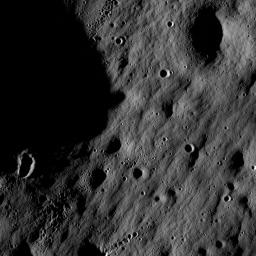
|
First LROC Images
- Click the image above for a larger view
- Full-Res JPEG (1000 x 1000) (160.3 kB)
- Full-Res TIFF (1000 x 1000) (1.0 MB)
Caption:
Full resolution detail from one of the first LROC NAC images. At this scale and lighting, impact craters dominate the landscape. Two general types of impact craters are readily identifiable. Solitary craters which most likely represent a single impact event, and clusters or chains of small, fresh craters produced by the impact of lunar material excavated by a larger impact. Image width is 1400 meters, north is down.
Background Info:
NASA's Goddard Space Flight Center built and manages the mission for the Exploration Systems Mission Directorate at NASA Headquarters in Washington. The Lunar Reconnaissance Orbiter Camera was designed to acquire data for landing site certification and to conduct polar illumination studies and global mapping. Operated by Arizona State University, the LROC facility is part of the School of Earth and Space Exploration (SESE). LROC consists of a pair of narrow-angle cameras (NAC) and a single wide-angle camera (WAC). The mission is expected to return over 70 terabytes of image data.
Cataloging Keywords:
| Name | Value | Additional Values |
|---|---|---|
| Target | Moon | |
| System | Earth | |
| Target Type | Satellite | |
| Mission | Lunar Reconnaissance Orbiter (LRO) | |
| Instrument Host | Lunar Reconnaissance Orbiter | |
| Host Type | Orbiter | |
| Instrument | Lunar Reconnaissance Orbiter Camera (NAC) | |
| Detector | Narrow Angle Camera (NAC), Wide Angle Camera (WAC) | |
| Extra Keywords | Crater, Grayscale, Impact | |
| Acquisition Date | ||
| Release Date | 2009-07-02 | |
| Date in Caption | ||
| Image Credit | NASA/GSFC/Arizona State University | |
| Source | photojournal.jpl.nasa.gov/catalog/PIA12884 | |
| Identifier | PIA12884 | |
